The Portrait in Erfurt Alleged to Depict Bach, the Weimar Concertmeister - Is this young man really Johann Sebastian Bach? Pages
at The Face Of Bach
Page 3
The Face Of Bach
This remarkable photograph is not a computer generated composite; the original of the Weydenhammer Portrait Fragment, all that
remains of the portrait of Johann Sebastian Bach that belonged to his pupil Johann Christian Kittel, is resting gently on the surface
of the original of the 1748 Elias Gottlob Haussmann Portrait of Johann Sebastian Bach.
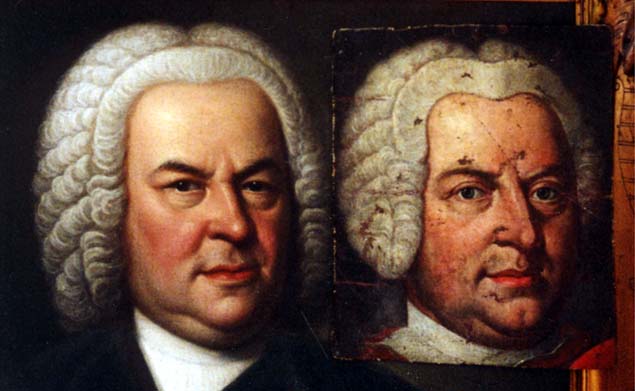
1748 Elias Gottlob Haussmann Portrait, Courtesy of William H. Scheide, Princeton, New Jersey
Weydenhammer Portrait Fragment, ca. 1733, Artist Unknown, Courtesy of the Weydenhammer Descendants
Photograph by Teri Noel Towe
©Teri Noel Towe, 2001, All Rights Reserved
The Portrait in Erfurt Alleged to Depict Bach, the Weimar Concertmeister
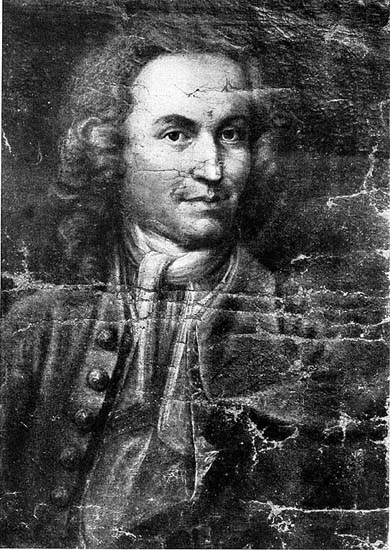

Before the 1907 Restoration and As It Looked in 1985
Is this young man really Johann Sebastian Bach?
Page 3
That it was felt necessary to alter the details of the portrait to make the face more "Bachian" is, to me at least, prima facie evidence
that its discoverers had reason to believe from the outset that the face in the battered and abraded portrait that they had acquired
from the Schneidermeister was not, in fact, the face of the young Johann Sebastian Bach but rather the face of a "near miss".
The history and the provenance of the painting now became a subject of intense interest.
Because it was nearest to hand, I turned first to Werner Neumann's commentary in Bilddokumente zur Lebensgeschichten Johann
Sebastian Bachs. This is what I found:
"...Oil on canvas 60x44 cm with no artist's signature, but earlier with the following words on the back in a reputedly
original rococo handwriting: 'Joh. Sebast. Bach / geb. d. 21 Mar. 1685 / zu Eisenach'. Found in about 1877 in the attic of
a house in Erfurt, owned until 1907 by a master tailor who collected pictures and bought from him by the
Angermuseum, the City Museum of Erfurt, renovated and declared by the director Alfred Overmann to be possibly a
picture of Bach...." (BDL, p. 403)
In Neumann's subsequent discussion of the controversy that developed about the painting's authenticity, Heinrich Besseler's name
looms large, and the Erfurt Portrait is the first of the five portraits that Besseler discusses in his monograph. Naturally, I turned it to
his discussion next. His account of the history of the painting provided significantly more detail but no new revelations, with one
possible exception. Besseler alludes to the article in Die Musik in which the existence of the portrait was first announced and its
identication as a portrait of Bach asserted, and he mentions that the article contains a photograph of the painting as it looked before
it was restored:
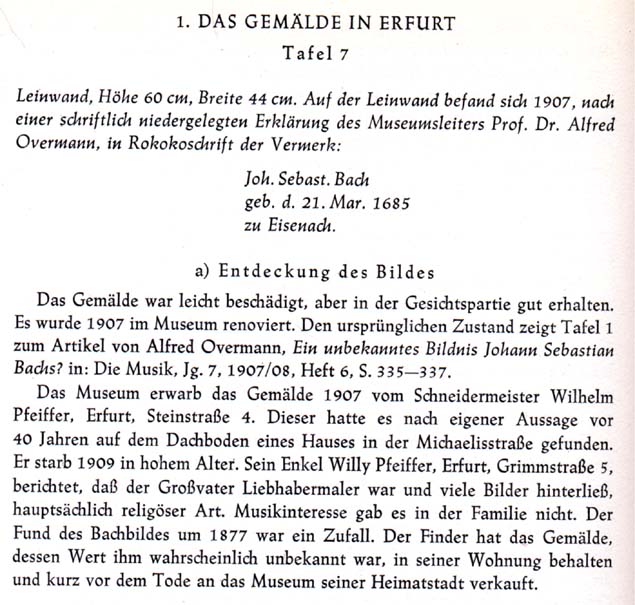
However, Besseler does not reproduce the photograph in his book, and he does not appear to discuss its potential significance in
his examination and evaluation of the Erfurt Portrait. One cannot help but wonder why, especially since there are twelve plates in the
book, which means that there was ample room in the budget to allow for the inclusion of the "before" photograph of the Erfurt
Portrait. Did Besseler simply rely on the restored painting, believing the photograph of the unrestored canvas of minimal probative
value, or did the photograph of the unrestored canvas cause him to have doubts that, under the circumstances, he preferred to
ignore? After all, had he decided that he had to exclude the painting from the canon, a thin book would have become even thinner,
and the title would have had to have been changed to Vier Echte Bildnisse Johann Sebastian Bachs.
And, at some point, I then realized, I really would have to find out what Museumleiter Prof. Dr. Alfred Overmann had to say about
the painting in his article announcing the momentous discovery.
Once again, however, I had to set aside dealing with what suddenly and irrevocably had transformed itself into the distasteful and
disheartening task of discrediting one of the most famous portrait images in the Western world. The joyful task of authenticating the
Weydenhammer Portrait Fragment and announcing to the world the re-appearance of the long lost Portrait of Bach that belonged to
Kittel, I am thankful to write, took precedence once again. First, the original of the Weydenhammer Portrait Fragment was entrusted
to my care, and then Rufus Hallmark and Raymond Erickson invited me to give the Queens College Lecture.
But, during the weeks and months of intense preparation for that historic and, for me at least, deeply moving presentation, I had the
good fortune to get to know Paula D. Matthews, who had succeeded my long time friend Paula Morgan as the Music Librarian at
my alma mater, Princeton University.
Paula, who quickly became as close a friend as her predecessor, reminded me that, as a Princeton alumnus, I still had the privilege
of roaming through the stacks of the Music Library. (God bless Karin Trainer and the rest of the Princeton librarians! They still
steadfastly decline to abandon Princeton's long-standing policy of having "open stacks"!) Paula also made it possible for me to
borrow for scanning purposes that 1914 Bach Jahrbuch that was the catalyst for the initial detour to an examination of the Erfurt
Portrait. Needless to say, I was, and am, immensely grateful.
At the same time, I asked Paula if, by some miracle, the Music Library had a copy of the issue of Die Musik in which the existence
of the Erfurt Portrait was first announced to the world. (Die Musik was a journal that had extremely high production values; among
the classical music periodicals in circulation today, almost a century later, only the early music magazine, Goldberg, equals it in
quality.) Mirabile dictu, the Music Library did, and Paula graciously allowed me to borrow that, too.
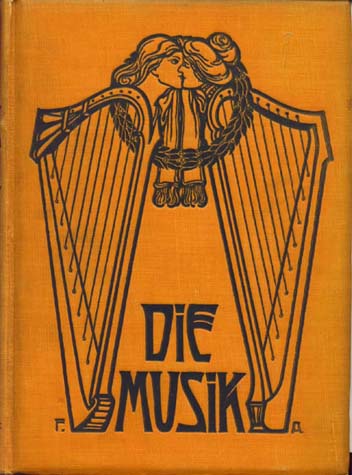
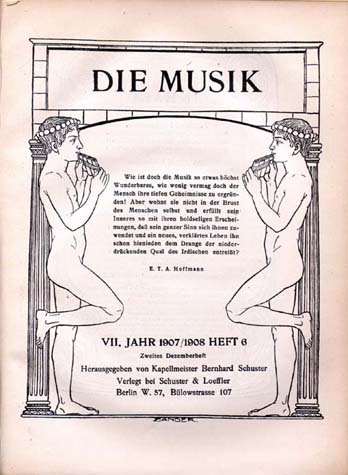
After my astonishment at the not very subtle erotically charged art work that graces the cover and the title page to the Volume had
dissipated, I turned at once to Alfred Overmann's article on the Erfurt Portrait.
The photo of the unrestored canvass in Heft 6 of the 1907 Die Musik turns out to be somewhat larger than the photo that is the
frontispiece of the Beyer monograph, and the photo of the restored canvass, evidently the first and the "official" one, was of
equivalent size. I thereupon decided that these two images are about as level a playing ground as any scholar could want, and,
unless otherwise stated, all subsequent scans of the Erfurt Portrait are taken from those two 1907 illustrations.
So, once more, I returned to the scanning bed. Here are scans of the "before and after" illustrations of the unrestored painting that
appear in Heft 6 of the 1907 Die Musik:
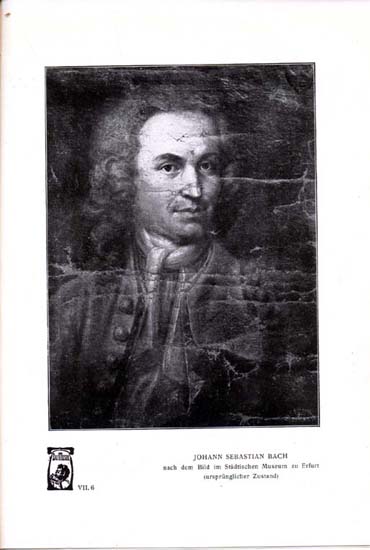
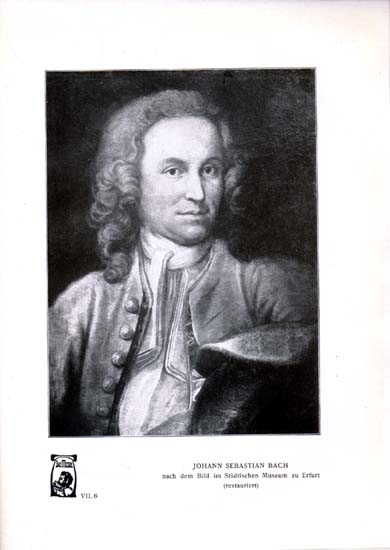
Here is that "before and after" comparison, shorn of captions and borders:

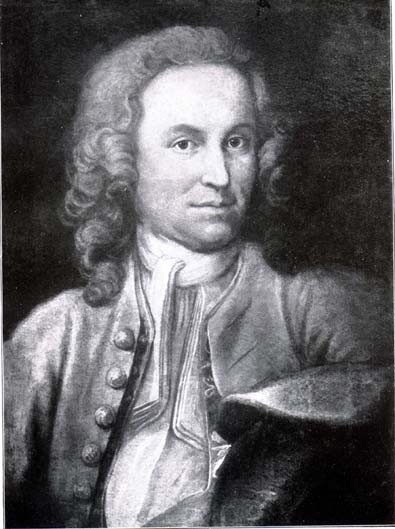
Now just the heads in that "before and after" comparison:

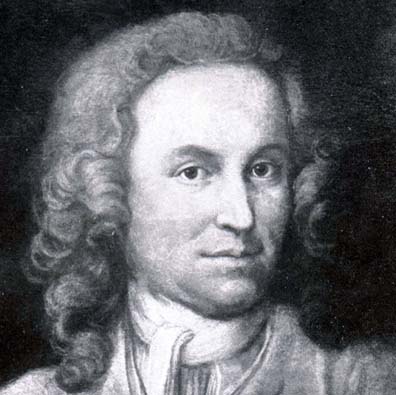
And now, finally, just the faces, without the distraction of hair (whether real or a perruque) and clothing:

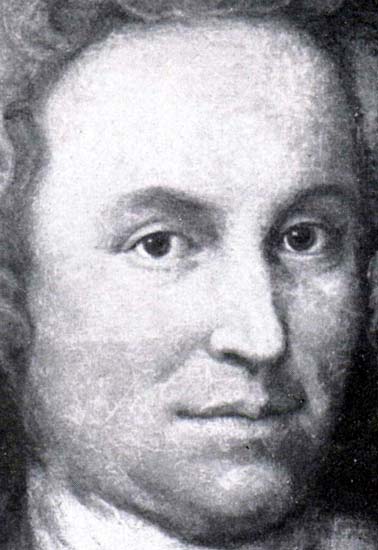
Alas, the verdict is unchanged. The "liberties" taken by the undeniably adept restorer are as apparent as before.
Please clibck on  to go on to Page 4.
to go on to Page 4.
Please click on  to return to the Index Page at The Face Of Bach.
to return to the Index Page at The Face Of Bach.
Please click on  to visit the Johann Sebastian Bach Index Page at Teri Noel Towe's Homepages.
to visit the Johann Sebastian Bach Index Page at Teri Noel Towe's Homepages.
Please click on the 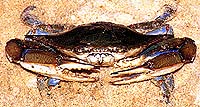 to visit the Teri Noel Towe Welcome Page.
to visit the Teri Noel Towe Welcome Page.
TheFaceOfBach@aol.com
Copyright, Teri Noel Towe, 2000 , 2002
Unless otherwise credited, all images of the Weydenhammer Portrait: Copyright, The Weydenhammer Descendants, 2000
All Rights Reserved
The Face Of Bach is a PPP Free Early Music website.

The Face Of Bach has received the HIP Woolly Mammoth Stamp of Approval from The HIP-ocrisy Home Page.